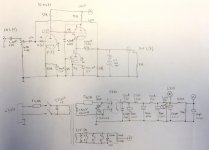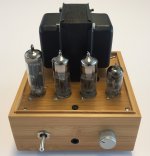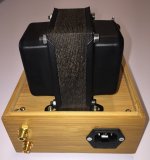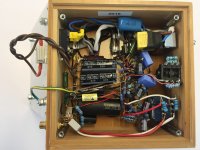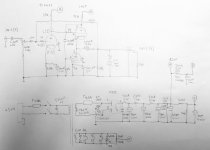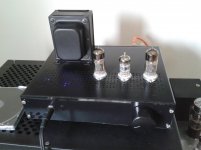Here the circuit you sent (with E88CC) and that I modified:
- added 6N6P anode current to 28 mA with R5
- adjusted lower input impedance (47k) and lower NFB with R6 to get more suitable gain (...just my opinion)
- re-biased E88CC to lower anode voltage (with R13 and R8) to bias 6N6P so that both triode halves have same power dissipation
- adjusted R2 to set 6N6P lower stage AC-drive to optimum
Now the THD = 0.12 % at 13 mW to 32 ohms. Originally it was THD = 0.3 % at 6.5 mW to 32 ohms.
Hi Arto,
I was wondering if an equivalent tube to the 6N6P may be the 12BH7, since I could have some...
This is my build of the schematic that Artosalo posted at #40. It works well with low impedence headphones such as Beoplay H6 and Superlux HD681evo. It is a good design, and is currently my reference headphone amp. As a bonus, the building cost has been very low because the power transformer is from a stereo tube radio from the '60, and I already had the tubes. It took time to made it work out as required. To the benefit of anyone else that may want to build it, I will briefly recap the issues I ran into.
My main error was to underestimate the power supply requirements. It turned out that this circuit requires a very clean, very stable power supply. A choke would have been the best choice, or a solid state filter. At first, the output was plagued by a faint 5 KHz whistle on both channels, picked up by the preamp stage. Moving the hands or metal objects around the E88CC will change the intensity of the signal. On a hindsight, the chassis should have been completely made of metal. I believe that this is a switching noise/ringing from the rectifiers, because I tamed it with a film capacitor between the output pin of the rectifier and ground. A greatly attenuated form of this noise is still there on perfect silence when I turn the volume potentiometer on the position of maximum output impedence, and the preamp tube is still cold, and I touch the volume knob. Maybe I should replace the 47k volume potentiometer with a 10k one.
The second issue has been a strong ultrasonic oscillation when the headphone jack is oxidized/not perfectly inserted in the socket. On this condition the crackling noise due to the bad contact will trigger the oscillation. Maybe the 33k resistors at the output are too high to guarantee stability in absence of a ground connection at the headphone. I solved it by replacing the original nice jack socket with a guitar-style one with much stronger spring action on the contacts and a integrated auxiliary switch that will connect 33 ohms resistors to the output when the jack is extracted from the socket. I am still searching for a socket of this type but with a longer span of the thread, that will fit in the 8mm depth of the front panel wood to avoid drilling a countersunk nut. The jack socket is glued in place, for now.
The third issue has been the preamp tube quality. E88CC Hi-Fi tubes are expensive, so at first I tried the TV tubes I already have in the drawer. I tried two dozen of ECC88, ECC189, PCC88 and PCC189 tubes. They all listed good at the tube tester, but only 5 of them turned out to be usable. All the others were microphonic, or had strong hissing/white noise. Actually, only 3 tubes (over 20+ I tried) have a low enough white noise background for my taste, so I am wondering if background white noise is normal on this tube type. By the way, the variable-mu ECC189 seems to be fine on this application, no obvious distorsion/compression.
I still thank Artosalo for the design, it is an excellent amplifier.
My main error was to underestimate the power supply requirements. It turned out that this circuit requires a very clean, very stable power supply. A choke would have been the best choice, or a solid state filter. At first, the output was plagued by a faint 5 KHz whistle on both channels, picked up by the preamp stage. Moving the hands or metal objects around the E88CC will change the intensity of the signal. On a hindsight, the chassis should have been completely made of metal. I believe that this is a switching noise/ringing from the rectifiers, because I tamed it with a film capacitor between the output pin of the rectifier and ground. A greatly attenuated form of this noise is still there on perfect silence when I turn the volume potentiometer on the position of maximum output impedence, and the preamp tube is still cold, and I touch the volume knob. Maybe I should replace the 47k volume potentiometer with a 10k one.
The second issue has been a strong ultrasonic oscillation when the headphone jack is oxidized/not perfectly inserted in the socket. On this condition the crackling noise due to the bad contact will trigger the oscillation. Maybe the 33k resistors at the output are too high to guarantee stability in absence of a ground connection at the headphone. I solved it by replacing the original nice jack socket with a guitar-style one with much stronger spring action on the contacts and a integrated auxiliary switch that will connect 33 ohms resistors to the output when the jack is extracted from the socket. I am still searching for a socket of this type but with a longer span of the thread, that will fit in the 8mm depth of the front panel wood to avoid drilling a countersunk nut. The jack socket is glued in place, for now.
The third issue has been the preamp tube quality. E88CC Hi-Fi tubes are expensive, so at first I tried the TV tubes I already have in the drawer. I tried two dozen of ECC88, ECC189, PCC88 and PCC189 tubes. They all listed good at the tube tester, but only 5 of them turned out to be usable. All the others were microphonic, or had strong hissing/white noise. Actually, only 3 tubes (over 20+ I tried) have a low enough white noise background for my taste, so I am wondering if background white noise is normal on this tube type. By the way, the variable-mu ECC189 seems to be fine on this application, no obvious distorsion/compression.
I still thank Artosalo for the design, it is an excellent amplifier.
Attachments
I managed to remove the residual tiny background noise.
1. Increased the second power supply dropping resistor to 330 ohms, it was 120 ohms previously. Both 330 resistors are now 15W panel mount type, screwed to the thick bottom metal plate.
2. added a LC filter cell to the preamp tube power supply. Triad C1X (15H , DCR = 1K) and 10 uF capacitor.
3. Added a metal shield on the side of the cabinet near to the preamp tube.
4. I also added a USB insulator (built with a Murata NMUSB202MC module) on the cable between the DAC and the computer. Noticeable reduction of the noise floor when volume is over 50%.
The amplifier is now dead quiet and very enjoyable.
1. Increased the second power supply dropping resistor to 330 ohms, it was 120 ohms previously. Both 330 resistors are now 15W panel mount type, screwed to the thick bottom metal plate.
2. added a LC filter cell to the preamp tube power supply. Triad C1X (15H , DCR = 1K) and 10 uF capacitor.
3. Added a metal shield on the side of the cabinet near to the preamp tube.
4. I also added a USB insulator (built with a Murata NMUSB202MC module) on the cable between the DAC and the computer. Noticeable reduction of the noise floor when volume is over 50%.
The amplifier is now dead quiet and very enjoyable.
Attachments
I haven't tried the E88CC, but a few more inexpensive NOS Polam ECC88 are on my way and I will test them first. I have got good results already with a Valvo Pcc88. Background noise is the major issue of most tubes I've tested: constant or intermittent white noise or barely audible whistles and crackles that come and go by lightly tapping on the preamp tube (tube socket and pins are clean), and also change in intensity when the tube warms up. Bad quality or worn used tubes, I guess. They all have come out from scrapped B&W TV sets.
I started this build with a low-cost goal because I was unsure of the results. I have severe space constraints and this Artosalo design is one of the most compact tube schematics I've found. I deliberately crammed the point-to-point wiring in a chassis that is too small: each internal side measures 13 cm - about 5 inches. It is still huge and comfortable to work with, compared to the modern SMD boards I am used to repair; but overheating and hum could have been a issue on a tube circuit. In the end it works nicely - no major issues. It is also somewhat serviceable, despite the hair-raising picture of the inside. I have tried a few more low impedence headphones, and it drives them all very well.
I started this build with a low-cost goal because I was unsure of the results. I have severe space constraints and this Artosalo design is one of the most compact tube schematics I've found. I deliberately crammed the point-to-point wiring in a chassis that is too small: each internal side measures 13 cm - about 5 inches. It is still huge and comfortable to work with, compared to the modern SMD boards I am used to repair; but overheating and hum could have been a issue on a tube circuit. In the end it works nicely - no major issues. It is also somewhat serviceable, despite the hair-raising picture of the inside. I have tried a few more low impedence headphones, and it drives them all very well.
NOS tubes for TV/radio use had about the same bad/good ratio as the used tubes I tried earlier. Bought 4 PCC88 NOS tubes from the same batch. 1 is perfect, 3 are microphonic (one of them horribly so). Still cheaper than a new 6922/E88CC, because I paid less than 3 euro each plus a very reasonable shipping rate, but I definitely will not buy a expensive NOS tube of this kind in the future unless there is a seller warranty. The original ECC88 application wasn't audio amplification and the old manufacturers clearly haven't tested for that.
I haven't tried the E88CC...
I took a look again on the schematic, and the previous ones. I have I doubt...on the 6N6P datasheet the maximum allowed V(h-k) is 100 V. Now by LTspice simulation this seems just to be to the limit. Should it be advisable to use a heater elevation circuit for proper working?
Nice build! I use my amplifier daily and it sounds even better now. The tubes needed a bit of burn-in. I tried several headphones and it works fine with all of them. It does not require expensive parts and it is easy to build in a point to point style. A good project, definitely.
The amplifier I described at post #45 and #46 has been in use since two years, so I had time to test it with several headphones and tubes. I post a few updates here because other people have built it and I believe that it is still a good design.
Reliability has been excellent with no issues at all despite almost daily use. The output tubes now have light stains on the glass and the getter has started to look a bit tired, but the emission is quite good and I plan to keep using them for a while. I am currently using a 6BK7A input tube, instead of the ECC88. The background noise is lower and my subjective opinion is that on this specific amplifier it sounds at least as good as the best ECC88 I've tried. Most 6BK7A tubes are microphonic, but I've found a few RCA branded tubes that have a sturdier internal construction and are just fine for audio use. I have removed the 10V zener protection at the output, because it was distorting the sound when using the 600 ohm version of Beyerdynamic DT990 headphones. No issues with the DT990 250 ohm version. I am not using this amplifier with 32 ohm headphones anymore, it seems to be unable to make them work optimally.
I only regret the choice of the bamboo chassis. The internal metal shielding I was forced to install does make servicing more difficult, and there is a slight discoloration of the top plate matherial next to the tube sockets. A metal chassis such as RS components stock number 517-3260 would have been a better choice; the removable cover of this enclosoure would be the amplifier bottom lid.
Reliability has been excellent with no issues at all despite almost daily use. The output tubes now have light stains on the glass and the getter has started to look a bit tired, but the emission is quite good and I plan to keep using them for a while. I am currently using a 6BK7A input tube, instead of the ECC88. The background noise is lower and my subjective opinion is that on this specific amplifier it sounds at least as good as the best ECC88 I've tried. Most 6BK7A tubes are microphonic, but I've found a few RCA branded tubes that have a sturdier internal construction and are just fine for audio use. I have removed the 10V zener protection at the output, because it was distorting the sound when using the 600 ohm version of Beyerdynamic DT990 headphones. No issues with the DT990 250 ohm version. I am not using this amplifier with 32 ohm headphones anymore, it seems to be unable to make them work optimally.
I only regret the choice of the bamboo chassis. The internal metal shielding I was forced to install does make servicing more difficult, and there is a slight discoloration of the top plate matherial next to the tube sockets. A metal chassis such as RS components stock number 517-3260 would have been a better choice; the removable cover of this enclosoure would be the amplifier bottom lid.
The amplifier I described at post #45 and #46 has been in use since two years, so I had time to test it with several headphones and tubes. I post a few updates here because other people have built it and I believe that it is still a good design.
Reliability has been excellent with no issues at all despite almost daily use. The output tubes now have light stains on the glass and the getter has started to look a bit tired, but the emission is quite good and I plan to keep using them for a while. I am currently using a 6BK7A input tube, instead of the ECC88. The background noise is lower and my subjective opinion is that on this specific amplifier it sounds at least as good as the best ECC88 I've tried. Most 6BK7A tubes are microphonic, but I've found a few RCA branded tubes that have a sturdier internal construction and are just fine for audio use. I have removed the 10V zener protection at the output, because it was distorting the sound when using the 600 ohm version of Beyerdynamic DT990 headphones. No issues with the DT990 250 ohm version. I am not using this amplifier with 32 ohm headphones anymore, it seems to be unable to make them work optimally.
I only regret the choice of the bamboo chassis. The internal metal shielding I was forced to install does make servicing more difficult, and there is a slight discoloration of the top plate matherial next to the tube sockets. A metal chassis such as RS components stock number 517-3260 would have been a better choice; the removable cover of this enclosoure would be the amplifier bottom lid.
I'd say that your setup behaved fine until now, after intensive use over two years it's natural that some components decay (especially tubes). I don't know 6BK7, but if you find this one playing better than ECC88 I'd leave like that and enjoy them.
As for the enclosure, metal chassis it makes sense. By the way, I'm finishing another OTL set in a bamboo wooden enclosure and I'm happy of this. If anything when all is ready I'll post here the picture.
The 220uf output coupling cap is fine with being polarized? I see the plus sign the schematic.
Yes. That capacitor is typically an electrolyte. The + should be at the cathode.
Hello,
I have 8 Ohm headphones, 4 6n13s tubes , some 6n6p and a lot of electronic components.
Is it possible to build an 8 ohms headphones amplifier like the original schematic,but using a pair of 6n13s?Please.
In fact i don't understand this cathode follower.
Regards
I have 8 Ohm headphones, 4 6n13s tubes , some 6n6p and a lot of electronic components.
Is it possible to build an 8 ohms headphones amplifier like the original schematic,but using a pair of 6n13s?Please.
In fact i don't understand this cathode follower.
Regards
Last edited:
- Status
- This old topic is closed. If you want to reopen this topic, contact a moderator using the "Report Post" button.
- Home
- Amplifiers
- Tubes / Valves
- The 6N13S "Artosalo" OTL headphone amplifier
